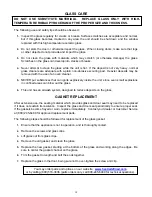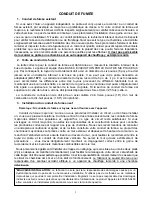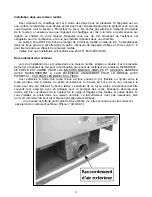
31
•
INSTALL
three
sheet
metal
screws
at
every
chimney
connector
joint.
•
AVOID
excessive
horizontal
runs
and
elbows,
as
both
will
reduce
the
draft
of
the
venting
system
and
will
result
in
poor
stove
performance.
•
INSPECT
your
venting
system
often,
to
be
certain
it
is
clear
of
creosote,
fly
‐
ash
and
other
restrictions.
•
CLEAN
the
venting
system
as
detailed
in
the
maintenance
section
of
this
manual.
•
ADHERE
to
the
10
‐
3
‐
2
rule
regarding
chimney
terminations.
•
INSTALL
single
wall
chimney
connector
with
the
male
end
down
to
prevent
creosote
leakage.
Follow
double
wall
chimney
connector
manufacturer’s
instructions
regarding
proper
pipe
installation.
WARNING
:
Venting
system
surfaces
get
HOT,
and
can
cause
burns
if
touched.
Noncombustible
shielding
or
guards
may
be
required
The
10
‐
3
‐
2
Rule:
The
chimney
system
must
terminate
3.0
ft
above
the
point
where
it’s
centerline
passes
through
the
roof
AND
the
chimney
must
terminate
2.0
ft.
above
part
of
the
dwelling
within
a
10
ft.
radius
of
the
chimney.
‐
Operation
and
Maintenance
–
Please
refer
to
the
‘Operation’
(Operating
Instructions)
and
Maintenance
(including
Ash
Removal/Disposal)
sections
of
your
owner’s
manual
and
follow
the
guidelines
listed
therein
for
safety
and
for
optimal
emissions
performance.
Additional
Information:
Following
the
instructions
in
your
owner’s
manual
for
Building
a
Fire
will
ensure
a
proper
fire,
as
well
as
helping
minimize
visible
emissions.
More:
‐
Fuel
loading
and
re
‐
loading:
Practical
Tips
for
Building
a
Fire
–
See
your
owner’s
manual
for
information
on
loading
(and
re
‐
loading)
your
fuel,
as
well
as
for
fire
‐
starting
procedures
(i.e.
‘Building
a
Fire’).
‐
Top
‐
Down
Fires:
The
US
EPA
recognizes
‘the
effectiveness
of
the
top
‐
down
approach
for
starting
fires.’
A
good
tutorial
for
this
approach
may
be
found
at
http://woodheat.org/top
‐
down
‐
steps.html
.
When
building
top
‐
down
fires,
be
sure
to
follow
the
instructions
found
in
your
owner’s
manual
and
contact
our
Technical
Support
if
you
have
any
questions.
‐
Fuel
Selection:
Once
your
wood
‐
burning
appliance
is
properly
installed,
building
an
effective
fire
requires
good
firewood
(using
the
right
wood
in
the
right
amount)
and
good
fire
building
practices.
The
following
practical
steps
will
help
you
obtain
the
best
efficiency
from
your
wood
stove
or
fireplace.
Season
wood
outdoors
through
the
summer
for
at
least
6
months
before
burning
it.
Properly
seasoned
wood
is
darker,
has
cracks
in
the
end
grain,
and
sounds
hollow
when
smacked
against
another
piece
of
wood.
Store
wood
outdoors,
stacked
neatly
off
the
ground
with
the
top
covered.
Burn
only
dry,
well
‐
seasoned
wood
that
has
been
split
properly.
Start
fires
with
newspaper
and
dry
kindling
as
discussed
earlier
in
the
manual.
Burn
hot
fires.
To
maintain
proper
airflow,
regularly
remove
ashes
from
your
wood
‐
burning
appliance
into
a
metal
container
with
a
cover
and
store
outdoors.
Содержание 13-NCC
Страница 20: ...20 Placement of Stainless Steel Burner Tubes for all 13 NCMH 50 SNC13MH and 50 TNC13MH stove models ...
Страница 29: ...29 ...
Страница 57: ...23 ...
Страница 60: ......
















































